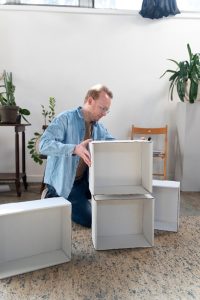7 Furniture Storing Tips for Safeguarding Your Items
Storing your furniture isn’t just about tossing old chairs and tables into a garage until further notice. It’s an art that, done correctly, can save you a heavy heart and an even heavier expense down the line.
Whether you’re moving, downsizing, or renovating your treasures—yes, that squishy couch and the dining table where you’ve celebrated countless birthdays—deserve to be protected and preserved.
Thus, it’s important to prepare and place them with care, so that when the time comes to reunite, they’re just as you remember them
Follow these 7 essential furniture storing tips to ensure your furniture stays in top-notch condition during its hibernation.
1. Clean Your Furniture Thoroughly

Before you tuck your furniture away for storage, give it a thorough clean. Why? It’s not just about making it look nice, it’s about safeguarding your beloved pieces from mold, mildew, and uninvited pests. Moisture is the enemy here; it can lead to a musty memory of what once was a splendid sofa or chair. By ensuring everything is bone-dry, you’ll be keeping those spore-slinging fiends at bay.
Cleaning Wooden Furniture
For each material, there’s a smart way to clean. Wooden furniture benefits from a gentle wipe-down with a damp cloth and mild soap, but don’t let it swim—too much water is a no-no. Condition it afterward to keep it from getting thirsty and cracking.
Cleaning Upholstered Items
When it comes to upholstered items, vacuuming is your first step. Spot-clean any blemishes with an upholstery-safe cleaner and let them dry completely, as dampness is a breeding ground for mold and odors. And those metal accents? A mild soap and water solution does the trick, followed by a thorough dry and maybe a touch of polish for extra protection.
Think of cleaning as a pre-storage pampering session that not only prevents any present damage from getting worse but also protects your furniture’s integrity during its hibernation period.
2. Disassemble Large Furniture Pieces
When you’re gearing up to store your hefty dressers and bookshelves, breaking them down into parts can be a game-changer. It’s like a puzzle; you want to make the most of your storage space, and disassembling turns unwieldy giants into manageable pieces. You’ll find it breezier to navigate those awkward staircases and narrow hallways with the furniture in smaller, more controllable segments.
Dismantle Beds and Tables First
Start this smart pack-up process by dismantling beds and tables first. Unscrew the bolts carefully, and if you bump into stubborn joints, a rubber mallet can gently coax them apart. For shelves, remove any brackets or supports and stack the wood neatly, keeping in mind that each piece should be wrapped individually for its protection.
Keep Everything Organized
Here’s a tip to keep everything organized: grab some sandwich bags and label them for different furniture hardware – think ‘desk screws’ or ‘bed frame bolts’. It’s a small step that’ll save you a giant headache later.
Plus, snapping some pictures or shooting a quick video as you go along provides a perfect visual aid for reassembly. And trust me, nothing feels better than putting everything back together without a single leftover screw.
3. Use Protective Covers
Protective covers as your first defense against wear and tear when storing your furniture. Covers are crucial as they prevent dust and debris from settling on your favorite pieces, which not only spares you a cleaning headache but also shields the furniture from potential damage.
Protects from Moisture and Humidity
Protective covers are like putting a raincoat on your furniture; the right cover keeps moisture and humidity at bay, reducing the risk of warping and unwanted growths like mold. And let’s talk sunlight – while a little bit of sunshine is great, too much can make your furniture’s colors fade. A protective cover is a perfect way to ensure the sun doesn’t dull the vibrant finish of your wood or fabric.
Prevents Nicks and Scratches
Now, imagine jostling your furniture in storage, and the accidental bumps that might occur – covers act like a cushion, helping prevent nicks, scratches, and dents. They’re not just physical barriers; they deter pests too, so when you retrieve your furniture, it’s just as you left it – pristine and unchewed.
Avoid Plastic Wrapping
For keeping your furnishings clean and well-maintained, a breathable cover is the way to go. Avoid plastic, folks; it’s a moisture magnet. Opt for cotton sheets or covers designed specifically for furniture. Good covering is like ensuring your furniture has a long, healthy life. Plus, by labeling them, you’ll know exactly what’s what without having to peek inside.
Padded Blankets for Valuable Furniture
Thinking of protecting your delicate wood tables or antique chairs? Use padded blankets. For sofas and loveseats, fitted slipcovers work great, offering a snug defense against the elements.
Remember, if you’re planning to store furniture for a while, particularly if you’re in the midst of a big move, properly covering your items is like giving your future self a pat on the back.
4. Choose the Right Storage Environment
The spot you choose when storing your furniture is more than just a corner to dump stuff—it’s a bulwark against total ruination. Think of extreme temperature swings as the arch-nemesis of your cherished wood pieces; they hate it.
Climate Controlled Storage for Furniture
So, if you’re not keen on seeing your elegant wood table sport unsightly cracks or your beloved leather couch start to look parched, a climate-controlled unit is akin to a superhero cape for them.
Now, if you think all storage units are created equal, think again! Fabrics and upholstery are like sponges for moisture; they’ll invite mold and mildew to a party that’ll ruin your furniture’s vibe.
And don’t get me started on pests—those critters love a cozy non-climate-controlled hideout. To shield your pieces from these fiends, opt for conditions where humidity and pests don’t stand a chance.
Consider Your Antiques
If you’ve got antiques or pieces, you’ve poured your heart and soul into selecting, you’d want to maintain their integrity and value. It’s simple—select a storage haven that matches the sensitivity of your furniture.
The golden rule? If it’s a short-term stint, regular units might do. But for the long haul, or if your furniture could be featured in a museum one day, a consistent and furniture-friendly environment is non-negotiable.
Not only does this keep your furniture in tip-top shape, ready for use at a moment’s notice, but it also gives you peace of mind. And let’s be honest, isn’t that what we all want?
4. Elevate Furniture Off the Ground
When you’re tucking away your cherished dresser or coffee table, think about keeping it lifted, like putting it on a little stage. This isn’t just for show – it’s a smart move to ward off unwanted moisture.
Imagine a glass left on a cold surface, soon there’s a ring of condensation, right? That’s what could happen to your furniture resting on a chilly garage floor. Moisture creeps up and, before you know it, your wood goes from chic to weak.
Use Pallets and Sturdy Blocks
Now, you’re savvy, so use your wits and hoist that furniture off the ground. Scoop up some pallets or sturdy blocks and give your pieces a leg-up. This is especially key if you’re in the middle of a big move or revamping your space. It’s like giving your furniture a little insurance policy against the whims of water.
Remember, you’re not just stashing furniture—you’re preserving your investment. By keeping your furniture off the damp ground, you’re saying a firm “no thanks” to the possibility of flooding tantrums.
5. Plan and Organize Your Storage Space
When you’re looking to store your furniture, the first step is to map out your storage space. Think like a chess player; every move should be strategic. Start by sketching a layout plan, marking where each piece will go. This foresight not only maximizes your space but also shields your furniture from possible damage due to overcrowding.
Make sure your heavy hitters, like sofas and tables, aren’t just tossed in. Place them on their feet or well-supported and consider going vertical with shelving to keep chairs aloft. You’ll thank yourself later for the extra floor space you’ve just created. And if you frequently need to retrieve items, label those boxes clearly and position them for easy access—it’s like having a personal storage butler.
Always think about the welfare of your furniture. Leave breathing room around each piece to combat moisture and unwelcome critters; this also makes spotting issues much simpler.
Grouping like items—think ‘all lamps in one corner’—keeps things organized and helps maintain a mental inventory of your treasures. And don’t forget to create aisles; these pathways are your golden ticket to navigating the storage space without a hassle.
Remember, an organized space not only looks great but also preserves your furniture and saves you time and stress in the long run.
Maple Leaf Self Storage: Your Trusted Storage Solution
Taking care of your cherished furniture pieces is crucial, especially when life’s transitions demand extra space. Maple Leaf Self Storage is prepared to meet your needs with versatile options tailored for furniture care. We offer climate-controlled units to shield your valuables from the unpredictable whims of temperature and humidity.
When it comes to unit sizes, versatility is key. Whether you’re storing a single cherished armchair or an entire home’s worth of furnishings, we have a range of spaces from small units to expansive ones, resembling a two-car garage. And security? It’s top-notch. With 24-hour video surveillance, coded access, and vigilant on-site managers, rest assured your items are in safe hands.
Whether you’re navigating a big move or simply reorganizing, the team at Maple Leaf Self Storage is here to lend our expertise. Give us a call and discover how we can help you maintain the integrity of your furniture during storage transitions.
Choosing The Right Storage Makes All the Difference
When it’s time to tuck away your cherished furniture pieces, choosing the right storage solutions can make all the difference. Opt for climate-controlled units to shield your belongings from fickle temperatures and humidity, which are vital in preserving the integrity of wood and leather. Remember, the size of the unit should match your storage demands; options range from compact closet space to substantial areas fit for a houseful of items.
Don’t forget to wrap up your furniture with the appropriate packing supplies on offer, which add an extra layer of protection against scuffs and dust. Cleanliness in the storage environment is a priority, and with pristine facilities, it is one less worry on your checklist. Plus, spacious loading zones make moving bulky pieces a breeze.
If your furniture needs a temporary home, reach out to Maple Leaf Self Storage. We’ve got your back in ensuring your furniture stays in top-notch condition during its storage tenure.
Share



